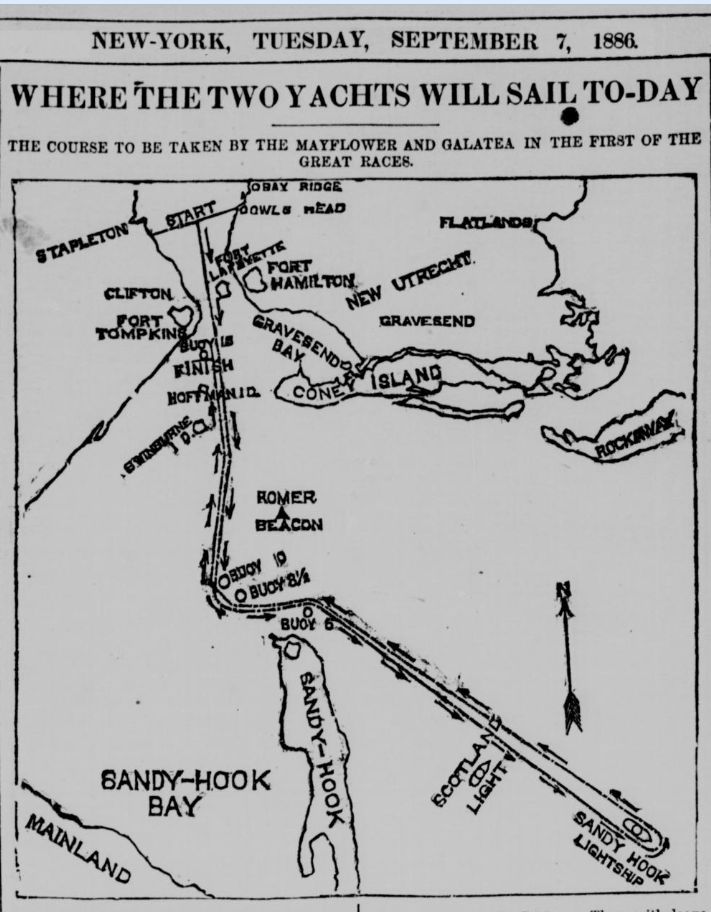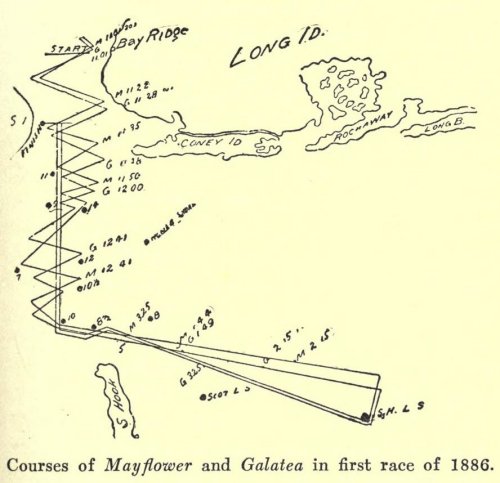
|
REF : 0
EDITION : 1886
DATE : 07 Sep 1886
COURSE : 1
DESCRIPTION SITE :
The course chosen for the first race was the regular one of the New York Yacht Club, starting from buoy 18, New York harbor.
NOTES AMERICA-SCOOP :The wind was from the south, compelling the yachts to beat down the Narrows, and was very light. As the prospect that it would increase in force was good, the committee having charge of the race decided to start the boats, and the preparatory signal was given. Then there began the most skilful sailing for position of which yachtsmen are capable, and sharp tactics were resorted to.
The Galatea, however, held the most advantageous position, and was able to keep it until the signal for the start was given, when she shot over the line at 10:56:11; the Mayflower following at 10:56:12 o'clock. Both yachts crossed on the starboard tack, the Mayflower carrying her main-sail, club-top-sail, forestay-sail, jib and jib- top-sail, and the Galatea the same, except that her jib-top-sail was not set. The start was a magnificent one, and was accompanied by a deafening roar of cannon and shriek of whistles from the attendant fleet.
 The
Galatea being to windward, the Mayflower made an effort to prevent being
blanketed, and soon crept a few feet to the front. The visitor, however, was
pointing closer into the wind. As they neared the Bay Ridge
shore, the sloop had a lead of two hundred feet, and, going about on
the port tack, was nearly on even terms. The Galatea tacked immediately, and
showed herself to be much quicker in stays. In standing toward the
Staten Island shore, the cutter was jammed so closely into the
wind that she moved heavily through the water, and the Mayflower was making a
very perceptible gap between herself and her rival.
The
Galatea being to windward, the Mayflower made an effort to prevent being
blanketed, and soon crept a few feet to the front. The visitor, however, was
pointing closer into the wind. As they neared the Bay Ridge
shore, the sloop had a lead of two hundred feet, and, going about on
the port tack, was nearly on even terms. The Galatea tacked immediately, and
showed herself to be much quicker in stays. In standing toward the
Staten Island shore, the cutter was jammed so closely into the
wind that she moved heavily through the water, and the Mayflower was making a
very perceptible gap between herself and her rival.
Both were affected by the strong flood-tide which was setting them to leeward, the Galatea suffering more than the Mayflower. At 11:03:30 the cutter's jib-top-sail was run up, but it did not prevent the Mayflower from still drawing away from her. As the yachts approached the Stapleton shore they found a large schooner anchored in their path. The Mayflower tried to weather it, and by luffing succeeded, but the English boat was obliged to go to leeward of it. Both kept close to the shore, the sloop going about at 11:13:30, and the cutter at 11:14:30 o'clock.
On this stretch the Mayflower made a considerable gain. She did not attempt to sail so high into the wind, hut under skillful handling kept good headway and in the light wind did creditable work. Mr. Beavor-Webb held the tiller of the iron boat, and Captain Stone was at the Mayflower's wheel, while the assistance and suggestions of Messrs. Paine and Burgess were invaluable. The Galatea was being pinched hard to offset in windward work what the Mayflower was doing in outfooting her, and was fully a quarter of a mile astern when the latter tacked, at 11:22:20. Short tacks ensued, the Mayflower making fifteen and the Galatea sixteen from the start to buoy 10, the sloop then leading fully three-fourths of a mile. The Mayflower rounded buoy 8 at 1:01:51, and the Galatea at 1:07:07.
From this point to the end of Sandy Hook the Galatea decreased the gap by holding better to windward against the tide than did the American boat. It was one long reach to the Sandy Hook Lightship, and the Mayflower's splendid sailing qualities added three minutes more to her advantage. She rounded the lightship on the starboard tack at 2:35:02, and her immense balloon jib-topsail was immediately broken out. The Galatea rounded at 2:44:13, and likewise set her balloon jib-top-sail, though by no means with the skill displayed by the Yankee crew.
In the reach back to the Hook, the sloop gained three minutes more, and passed buoy 8 at 3.34, followed by the Galatea at 3. 40 o'clock. With a slightly freshening wind, the boats began their run home before it, though the Boston boat did not set her spinnaker until she was within a mile of the finish. Five minutes before the cutter's spinnaker had been set, and both boats were bowling along at good speed, accompanied by the fleet of steam craft which crowded in on all sides. The Mayflower finished at 5:26:41, with a lead of one and one-half miles, and the Galatea at 5:39:21. Each received a salute, which continued for many minutes, steam-whistles and cannons sounding their loud acclaim.

Autorisation en cours
| LIENS VERS CE DOCUMENT | ||||
| SITE | LARG | HAUT | ADRESSE | |
 |
Library of Congress | 711 | 912 | http://chroniclingamerica.loc.gov/lccn/sn83030214/1886-09-08/ed-1/seq-1/ |